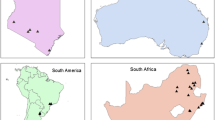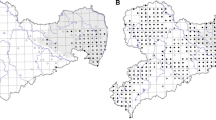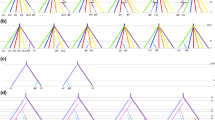Abstract
Invasive species are a major threat to biodiversity and ecosystem function. Thus, understanding their spread and ecological impacts is critical for management and control. Strawberry guava (Psidium cattleianum Sabine) is an aggressive invader across the tropics and has been rapidly spreading throughout the eastern rainforests of Madagascar. However, both the mechanisms of its spread on the island and the consequences of its invasion on native floral and faunal communities remain largely unexplored. By surveying multiple sites across Madagascar’s eastern rainforests, we demonstrate that the introduction of P. cattleianum significantly correlates with changes in forest structure—namely tree/shrub size, taxonomic richness, and taxonomic diversity. Further, at a local scale, the presence of P. cattleianum was associated with an increase in frugivore species richness; its primary dispersers during our study period were lemurs. Moreover, we identified species-specific effects of lemur gut-passage on the germination of P. cattleianum seeds. Finally, microsatellite analysis of P. cattleianum from a variety of locations across Madagascar demonstrated three distinct, highly differentiated, genetic population clusters, each with high levels of intra-population diversity, suggesting multiple independent introductions of P. cattleianum into Madagascar followed by long-distance dispersal. Collectively, these findings illuminate the complex status of strawberry guava invasion in Madagascar, which poses a growing threat to the island’s unique flora and yet provides important forage for threatened and charismatic animal species.






Similar content being viewed by others
References
Abdelkrim J, Pascal M, Calmet C, Samadi S (2005) Importance of assessing population genetic structure before eradication of invasive species: examples from insular Norway rat populations. Conserv Biol 19:1509–1518
Allendorf F, Phelps S (1981) Use of allelic frequencies to describe population structure. Can J Fish Aquat Sci 38:1507–1514
Allnutt T, Ferrier S, Manion G et al (2008) A method for quantifying biodiversity loss and its application to a 50-year record of deforestation across Madagascar. Conserv Lett 1:173–181
Andriaholinirina N, Baden A, Blanco M et al (2014a) Eulemur rubriventer. The IUCN red list of threatened species e.T8203A16117921. Downloaded on 21 May 2020
Andriaholinirina N, Baden A, Blanco M et al (2014b) Eulemur rufifrons. The IUCN red list of threatened species e.T136269A16118038. Downloaded on 21 May 2020
Andriaholinirina N, Baden A, Blanco M et al (2014c) Varecia variegata. The IUCN red list of threatened species e.T22918A16121857. Downloaded on 21 May 2020
Asner GP, Hughes RF, Vitousek PM et al (2008) Invasive plants transform the three-dimensional structure of rain forests. Proc Natl Acad Sci 105:4519–4523
Barkman TJ, Klooster MR, Gaddis KD et al (2017) Reading between the vines: hosts as islands for extreme holoparasitic plants. Am J Bot 104:1382–1389
Bates D, Mächler M, Bolker B, Walker S (2015) Fitting linear mixed-effects models using lme4. J Stat Softw 67:1–48
Berglund H, Järemo J, Bengtsson G (2008) Endemism predicts intrinsic vulnerability to nonindigenous species on islands. Am Nat 174:94–101
Bergstrom DM, Lucierr A, Kiefer K et al (2009) Indirect effects of invasive species removal devastate World Heritage Island. J Appl Ecol 46:73–81
Brown KA, Gurevitch J (2004) Long-term impacts of logging on forest diversity in Madagascar. Proc Natl Acad Sci USA 101:6045–6049
Carrière SM, Randrianasolo E, Hennenfent J (2008) Protected areas and control of bioinvasions: conflicting objectives? The case of Psidium cattleianum Sabine (Myrtaceae) around Ranomafana National Park, Madagascar. VertigO—La Revue Electronique en Sciences de l’Environment 8:1–27
Chave J, Coomes D, Jansen S et al (2009) Towards a worldwide wood economics spectrum. Ecol Lett 12:351–366. https://doi.org/10.1111/j.1461-0248.2009.01285.x
Date E, Recher H, Ford H, Stewart D (1996) The conservation and ecology of rainforest pigeons in Northeastern New South Wales. Pac Conserv Biol 2:299–308
Donati G, Santini L, Eppley TM et al (2017) Low levels of fruit nitrogen as drivers for the evolution of Madagascar’s primate communities. Sci Rep 7:1–9
Dong M, Lu B, Zhang H et al (2006) Role of sexual reproduction in the spread of an invasive clonal plant Solidago canadensis revealed using intersimple sequence repeat markers. Plant Species Biol 21:13–18
Dukes JS, Mooney HA (1999) Does global change increase the success of biological invaders? Trends Ecol Evol 14:135–139
Dunham AE, Razafindratsima OH, Rakotonirina P, Wright PC (2018) Fruiting phenology is linked to rainfall variability in a tropical rain forest. Biotropica 50:396–404. https://doi.org/10.1111/btp.12564
Elton C (1958) The ecology of invasions by animals and plants. Methuen, London
Enquist BJ, Feng X, Boyle B et al (2019) The commonness of rarity: global and future distribution of rarity across land plants. Sci Adv 5:eaaz0414
Eppley TM, Donati G, Ramanamanjato J-B et al (2015) The use of an invasive species habitat by a small folivorous primate: implications for lemur conservation in Madagascar. PLoS ONE 10:e0140981. https://doi.org/10.1371/journal.pone.0140981
Ganzhorn JU (1987) A possible role of plantations for primate conservation in Madagascar. Am J Primatol 12:205–215
Ganzhorn JU, Malcomber S, Andrianantoanina O, Goodman SM (1997) Habitat characteristics and lemur species richness in Madagascar. Biotropica 29:331–343
GBIF (2019) GBIF occurrence download https://doi.org/10.15468/dl.xaxqbm
Gérard A, Ganzhorn JU, Kull CA, Carrière SM (2015) Possible roles of introduced plants for native vertebrate conservation: the case of Madagascar. Restor Ecol 23:768–775. https://doi.org/10.1111/rec.12246
Goodman SM, Benstead JP (2005) Updated estimates of biotic diversity and endemism for Madagascar. Oryx 39:73–77
Graves S, Shapiro A (2003) Exotics as host plants of the California butterfly fauna. Biol Conserv 110:413–433
Gurevitch J, Padilla DK (2004) Are invasive species a major cause of extinctions? Trends Ecol Evol 19:470–474
Hannah L, Roehrdanz PR, Marquet PA et al (2020) 30% land conservation and climate action reduces tropical extinction risk by more than 50%. Ecography
Hardin G (1960) The competitive exclusion principle. Science 131:1292–1297
Hending D, Andrianiaina A, Rakotomalala Z, Cotton S (2018) The use of vanilla plantations by lemurs: encouraging findings for both lemur conservation and sustainable agroforestry in the Sava Region, Northeast Madagascar. Int J Primatol 39:141–153. https://doi.org/10.1007/s10764-018-0022-1
Huenneke LF, Vitousek PM (1990) Seedling and clonal recruitment of the invasive tree Psidium cattleianum: implications for management of native Hawaiian forests. Biol Conserv 53:199–211
Invasive Species Compendium (2018) Psidium cattleianum (strawberry guava). https://www.cabi.org/isc/datasheet/45135
Kherwar D, Usha K, Mithra S, Singh V (2018) Microsatellite (SSR) marker assisted assessment of population structure and genetic diversity for morpho-physiological traits in guava (Psidium guajava L.). J Plant Biochem Biotechnol 27:284–292
Kull CA, Tassin J, Carrière SM (2015) Approaching invasive species in Madagascar. Madagascar Conserv Dev 9:60. https://doi.org/10.4314/mcd.v9i2.2
LaRosa A, Smith C, Gardner D (1985) Role of alien and native birds in the dissemination of fir-tree (Myrica faya Ait.-Myricaceae) and associated plants in Hawaii. Pac Sci 39:372–378
Lewis SL, Sonké B, Sunderland T, Begne SK, Lopez-Gonzalez G, Van Der Heijden GM, Phillips OL, Affum-Baffoe K, Baker TR, Banin L, Bastin JF (2013) Above-ground biomass and structure of 260 African tropical forests. Philos Trans R Soc B Biol Sci 368(1625):20120295
Linnebjerg J, Hansen D, Bunbury N, Olesen J (2010) Diet composition of the invasive red-whiskered bulbul Pycnonotus jocosus in Mauritius. J Trop Ecol 26:347–350
Martin P, Newton A, Bullock J (2017) Impacts of invasive plants on carbon pools depend on both species’ traits and local climate. Ecology 98:1026–1035
Morton J (1987) Cattley guava. In: Morton J (ed) Fruits in warm climates. Julia F. Morton, Miami, pp 363–364. ISBN: 0-9610184-1-0
Novy J (1997) Medicinal plants of the eastern region of Madagascar. J Ethnopharmacol 55:119–126
Olden J, Poff N (2003) Toward a mechanistic understanding and prediction of biotic homogenization. Am Nat 162:442–460
Olson DM, Dinerstein E, Wikramanayake ED et al (2001) Terrestrial ecoregions of the world: a new map of life on earth: a new global map of terrestrial ecoregions provides an innovative tool for conserving biodiversity. BioScience 51:933–938. https://doi.org/10.1641/0006-3568(2001)051%5b0933:TEOTWA%5d2.0.CO;2
Park DS, Razafindratsima OH (2019) Anthropogenic threats can have cascading homogenizing effects on the phylogenetic and functional diversity of tropical ecosystems. Ecography 42:148–161
Park DS, Feng X, Maitner BS et al (2020a) Darwin’s naturalization conundrum can be explained by spatial scale. PNAS 117:10904–10910. https://doi.org/10.1073/pnas.1918100117
Park DS, Willis CG, Xi Z, Kartesz JT, Davis CC, Worthington S (2020b) Machine learning predicts large scale declines in native plant phylogenetic diversity. New Phytol. https://doi.org/10.1111/nph.16621
Patel S (2012) Exotic tropical plant Psidium cattleianum: a review on prospects and threats. Rev Environ Sci Bio/Technol 11:243–248
Pattison R, Goldstein G, Ares A (1998) Growth, biomass allocation and photosynthesis of invasive and native Hawaiian rainforest species. Oecologia 117:449–459
Phillipson P, Lowry P, Andriamahefarivo L et al (2010) Flora of the Ambatovy-Analamay mine site and comparison to other sites in Madagascar. Malagasy Nat 3:44–76
Pinheiro J, Bates D, DebRoy S et al (2017) Package ‘nlme.’ Linear and nonlinear mixed effects models, version 3-1
Pino J, Marbot R, Vázquez C (2001) Characterization of volatiles in strawberry guava (Psidium cattleianum Sabine) fruit. J Agric Food 49:5883–5887
R Core Team (2019) R: a language and environment for statistical computing. R Foundation for Statistical Computing, Vienna
Rajaonarimamy E, Rakotomalala JY, Andrianarisoa BRH et al (2017) Impact of Psidium cattleianum invasion on soil microbial functioning and on Uapaca ferruginea (Baill.) Regeneration at forest edge in the eastern part of Madagascar. Int J Ecosyst 7:17–20. https://doi.org/10.5923/j.ije.20170701.03
Ramananjato V, Rakotomalala Z, Park DS et al (2020) The role of nocturnal omnivorous lemurs as seed dispersers in Malagasy rain forests. Biotropica. https://doi.org/10.1111/btp.12789
Razafimanantsoa TM, Haubruge E, Verheggen FJ (2012) Silk moths in Madagascar: biology, uses and challenges related to Borocera cajani (Boisduval, 1833) (Lepidoptera–Lasiocampidae). BASE 16:269–276
Razafindratsima OH (2014) Seed dispersal by vertebrates in Madagascar’s forests: review and future directions. MCD 9:90–97
Razafindratsima OH, Dunham AE (2015) Assessing the impacts of nonrandom seed dispersal by multiple frugivore partners on plant recruitment. Ecology 96:24–30. https://doi.org/10.1890/14-0684.1
Razafindratsima OH, Dunham AE (2016) Frugivores bias seed-adult tree associations through non-random seed dispersal: a phylogenetic approach. Ecology 97:2094–2102
Razafindratsima OH, Dunham AE (2019) Fruit/seed traits and phenology of trees in Ranomafana National Park, Madagascar. Dryad Data Repos. https://doi.org/10.5061/dryad.g4n11
Razafindratsima OH, Jones TA, Dunham AE (2014) Patterns of movement and seed dispersal by three lemur species. Am J Primatol 76:84–96. https://doi.org/10.1002/ajp.22199
Razafindratsima OH, Brown KA, Carvalho F et al (2017) Data from: Edge effects on components of diversity and above-ground biomass in a tropical rainforest. Dryad Data Repos. https://doi.org/10.5061/dryad.jn743
Razafindratsima OH, Brown KA, Carvalho F et al (2018) Edge effects on components of diversity and above-ground biomass in a tropical rainforest. J Appl Ecol. https://doi.org/10.1111/1365-2664.12985
Rejmánek M (1996) Species richness and resistance to invasions. In: Oriana GH, Dirzo R, Cushman JH (eds) Biodiversity and ecosystem processes in tropical forests. Ecological Studies (Analysis and Synthesis). Springer, Berlin, Heidelberg, pp 153–172
Rejmánek M, Richardson DM (1996) What attributes make some plant species more invasive? Ecology 77:1655–1661
Riondato I, Donno D, Roman A et al (2019) First ethnobotanical inventory and phytochemical analysis of plant species used by indigenous people living in the Maromizaha forest, Madagascar. J Ethnopharmacol 232:73–89
Risterucci A, Duval M, Rohde W, Billotte N (2005) Isolation and characterization of microsatellite loci from Psidium guajava L. Mol Ecol Notes 5:745–748
Sakai A, Allendorf F, Holt J et al (2001) The population biology of invasive species. Annu Rev Ecol Syst 32:305–332
Schatz GE (2001) Generic tree flora of Madagascar. Royal Botanical Gardens, Kew & Missouri Botanical Gardens, Great Britain
Schmidt DA, Iambana RB, Britt A et al (2010) Nutrient composition of plants consumed by black and white ruffed lemurs, Varecia variegata, in the Betampona Natural Reserve, Madagascar. Zoo Biol 29:375–396
Seebens H, Essl F, Dawson W et al (2015) Global trade will accelerate plant invasions in emerging economies under climate change. Glob Change Biol 21:4128–4140
Shannon CE (1948) A mathematical theory of communication. Bell Syst Tech J 27:379–423
Shiels A (2011) Frugivory by introduced black rats (Rattus rattus) promotes dispersal of invasive plant seeds. Biol Invasions 13:781–792
Shiels AB, Drake DR (2011) Are introduced rats (Rattus rattus) both seed predators and dispersers in Hawaii? Biol Invasions 13:883–894
Slik JF, Paoli G, McGuire K, Amaral I, Barroso J, Bastian M, Blanc L, Bongers F, Boundja P, Clark C, Collins M (2013) Large trees drive forest aboveground biomass variation in moist lowland forests across the tropics. Glob Ecol Biogeogr 22(12):1261–1271
Spellerberg IF, Fedor PJ (2003) A tribute to Claude Shannon (1916–2001) and a plea for more rigorous use of species richness, species diversity and the ‘Shannon–Wiener’Index. Glob Ecol Biogeogr 12:177–179
Turk R (1997) Identification of the potential of indigenous trees for forestry and agroforestry uses in the eastern periphery zone of Ranomafana National Park. Ph.D. thesis, North Carolina State University
Vila M, Espinar J, Hejda M et al (2011) Ecological impacts of invasive alien plants: a meta-analysis of their effects on species, communities and ecosystems. Ecol Lett 14:702–708
Wagner WL, Herbst DR, Sohmer SH (1999) Manual of the flowering plants of Hawai’i, vols 1 and 2. University of Hawai’i and Bishop Museum Press
Webber AD, Solofondranohatra JS, Razafindramoana S et al (2019) Lemurs in cacao: presence and abundance within the shade plantations of Northern Madagascar. Folia Primatologica, pp 1–12
Wenny DG (2001) Advantages of seed dispersal: a re-evaluation of directed dispersal. Evol Ecol Res 3:51–74. https://doi.org/10.1073/pnas.95.11.6204
Wright PC, Erhart EM, Tecot S et al (2012) Long-term lemur research at Centre Valbio, Ranomafana National Park, Madagascar. In: Kappeler P, Watts DP (eds) Long-term field studies of primates. Springer, Berlin Heidelberg, pp 67–100
Zanne AE, Lopez-Gonzalez G, Coomes DA et al (2009) Data from: Towards a worldwide wood economics spectrum. Dryad Digital Repos. https://doi.org/10.5061/dryad.234
Zavaleta ES, Hobbs RJ, Mooney HA (2001) Viewing invasive species removal in a whole-ecosystem context. Trends Ecol Evol 16:454–459
Acknowledgements
This research was funded by the Herchel Smith-Harvard Undergraduate Science Research Program; Harvard University Herbaria Grants-In-Aid of Undergraduate Research; Elizabeth Gardner Norweb Summer Environmental Studies Scholarships (Garden Club of America); and Weissman International Internship Program Grant to CMMD; and a Daniel and Sarah Hrdy Fellowship in Conservation Biology and Rufford Small Grants (# 21446-D) to OHR and DSP. We thank the local field technicians who were instrumental in the data collection, specifically Nerée, Manana, Tolotra, Jean François, Sylvain, Raelison, Seraphin, Jean, Maurice, Maka, Emilys, Augustin, Jean Robert, Jean Clément, Leontine, Jocelyn, Dominique, Francois, and Rakoto. We also thank Association Mitsinjo, Centre ValBio, Groupe d’Etude et de Recherche en Primatologie, Madagascar Flora and Fauna Group, Madagascar National Parks, Madagascar Biodiversity Partnership, Mention Zoologie et Biodiveristé Animale (University of Antananarivo), Qit Madagascar Minerals and Association Ary Saina for logistical support and for research authorization in their respective sites as applicable. We also thank Missouri Botanical Garden in Madagascar for support in facilitating the export of our leaf samples, the Ministère de l’Environnement et du Développement Durable in Madagascar for granting research permits to work in the various forests in Madagascar. Finally, we thank Harvard University Herbaria and New York Botanical Garden for access to P. cattleianum herbarium samples from the Neotropics.
Author information
Authors and Affiliations
Corresponding authors
Additional information
Publisher's Note
Springer Nature remains neutral with regard to jurisdictional claims in published maps and institutional affiliations.
Electronic supplementary material
Below is the link to the electronic supplementary material.
Rights and permissions
About this article
Cite this article
DeSisto, C.M.M., Park, D.S., Davis, C.C. et al. An invasive species spread by threatened diurnal lemurs impacts rainforest structure in Madagascar. Biol Invasions 22, 2845–2858 (2020). https://doi.org/10.1007/s10530-020-02293-7
Received:
Accepted:
Published:
Issue Date:
DOI: https://doi.org/10.1007/s10530-020-02293-7




